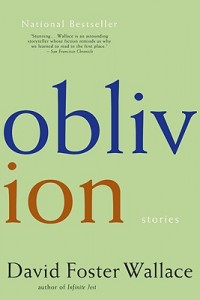 Twice recently, while riding the train—once from where I live in North Portland to Portland State University, where I spend my days trying to get better at reading and writing, and once on the return trip—I’ve noticed someone reading the collection Oblivion, and both times I’ve found myself wondering if, hoping really, the someone was reading a particular story from that book: “Good Old Neon.”
Twice recently, while riding the train—once from where I live in North Portland to Portland State University, where I spend my days trying to get better at reading and writing, and once on the return trip—I’ve noticed someone reading the collection Oblivion, and both times I’ve found myself wondering if, hoping really, the someone was reading a particular story from that book: “Good Old Neon.”
“Good Old Neon” offers in heartbreaking detail a first-person account of the psychological suffering that leads the apparent narrator, Neal, to suicide. The story begins, “My whole life I’ve been a fraud,” and goes on to unpack the causes and consequences of that statement for Neal. For Neal, I write, because these causes and consequences are very much Neal’s private concerns. That is, objectively Neal’s life is not exceptionally fraudulent, except possibly insofar as he is troubled by the existence of fraudulence and still unable to remedy the situation. It is for Neal the very gap between his own subjective experience of fraudulence and some idealized guileless state, which his self-consciousness necessarily precludes, that defines his troubles. By holding himself to the non-existent and impossible standard of purified intentions he makes the perfect the enemy of the good and undermines the possibility that any of his actions might ever feel sincere. Think about how sad this is. Everything he does comes with a sick Kantian guilt that even when he acts in the right way he does so for the wrong (narcissistic) reasons, and can never not do right without impure motives. It’s a hellish way to live.
The question the text seems to be asking is, Does Neal have options? Is there an escape from the torturous self-reflexivity of self-consciousness? Neal dies of course, but the story itself ends with optimism for the chances of making it in the world. Another character, David Wallace, former classmate of Neal, it turns out, is imagining (it’s hard not to say projecting) what Neal must have gone through in his suicide. Along the way the Wallace character confesses that he has survived “years of literally indescribable war against himself,” and the reader is left hopeful that others who suffer similarly might also survive. What complicates all this of course is that the author of “Good Old Neon” is David Foster Wallace, who in September ’08 took his own life.
So what do readers on the train make of this story? What do I hope to find in their faces?
The context for “Good Old Neon,” the extra-textual frame of an already framed story (which I’ll summarize, Russian-doll style, in a footnote1) raises certain questions about the relationship (in this case mediated by characters) between the author and his readers. Fair or not, it’s irresistible now, when reading “Good Old Neon,” to read it onto David Foster Wallace himself. Neal says we
go around trying to use English … to convey to other people what we’re thinking and to find out what they’re thinking, when in fact deep down everybody knows it’s a charade and they’re just going through the motions. What goes on inside is just too fast and huge and all interconnected for words to do more than barely sketch the outlines of at most one tiny little part of it at a given instant…
And we can argue with him that we do in fact feel him, or we can take up the same argument with the author. The existence of “Good Old Neon” (and what it does to the reader, to this reader) is indisputable anecdotal evidence that the above quote is strictly speaking true in letter but altogether banal and beside the point in spirit. There might always be an epistemological gap between me and Neal, or between me and Wallace the author, but the character Wallace is right when he calls this fact “hoary and insipid.” Recognizing this insipidness is what separates the Wallace character from Neal and what allows him to go on to say that he is “at the same time trying very consciously to prohibit that awareness from mocking the attempt or sending the whole line of thought into the sort of inbent spiral that keeps you from ever getting anywhere.”
Wallace the author puts Wallace the character’s antidote to Neal’s solipsism into practice by writing a story that communicates Neal’s incommunicables—his solipsism, his fraudulence, his subjective experience of being himself, his I—so fully. To this reader at least, the experience of reading “Good Old Neon” takes the ground out from under Neal’s fears (not from their existence—who am I to say?—but from under the urgency they should have had). Did Wallace the author agree with me? Did he think the antidote was effective? The temptation to read Neal’s fears of fraudulence onto David Foster Wallace remains. Whether his suffering was of the same variety as Neal’s, or just analogously similar in that both were stuck in perspectives that given a larger viewpoint they may have seen out of, or totally distinct in kind, I don’t know. Life and death are complicated, and this kind of speculative biography is dangerous. All I can deal with are the facts. And the facts are the words in the story and the people in trains all over Portland (and all over the world, I hope) reading them.
The real question is not what the story tells us about its author but what it tells us about us. David Foster Wallace may have written “Good Old Neon” for any of the kinds of reasons suggested by Neal (because he wanted to manipulate the reader into feeling something; because he wanted the reader to think he was smart, talented, a good writer) or for the kinds of reasons suggested by the Wallace character (because he thought them true or at least useful; because he wanted to out-contextualize Neal to give himself hope), but none of the reasons matter. What matters are the story we’re left with and what we make of it.

So here’s what I think I’m looking for on the faces of everyone riding the yellow line, reading Oblivion. I’m looking for them to get to that line where Neal denounces the capacity of language, I’m looking for them to pause and reread it, and maybe reread it again, and work up the courage, whether by abstract inference or heartfelt empathy—or both— to say, “I don’t think that’s right.”
What I want is to find on their faces the confirmation that however inexact our language (because Neal’s right that the gap exists), ultimately it works (it spans the gap when we care); we get it. And if we get it maybe we can get one another, and if we can get one another maybe we can accept one another, and if we can accept one another maybe we can even accept our own flawed selves. And maybe honest, generous, rattle-you-to-your-fucking-bones art can help with that.
Note
1. David Foster Wallace (who wrote about David Wallace, a character who (imagines himself into the conscious experience of an acquaintance who killed himself and) resolves not kill himself despite years of his own personal torment) killed himself.
For Further Reading
- Read more about Wallace’s life, work, and life-long struggle with depression in this Rolling Stone profile.
- Wallace’s wonderful — yet undeniably dark — commencement address to Kenyon College students in 2005 was widely forwarded, written about, anthologized, and excerpted in the New York Times and the Wall Street Journal; eventually it was published as a stand-alone book called This is Water.
- All of the stories and essays David Foster Wallace contributed to Harper’s between 1989 and 2008 are available online.
- Here’s his story “Good People” in the New Yorker.
- If you’re looking for a copy of Oblivion, consider ordering from your local independent bookstore.





